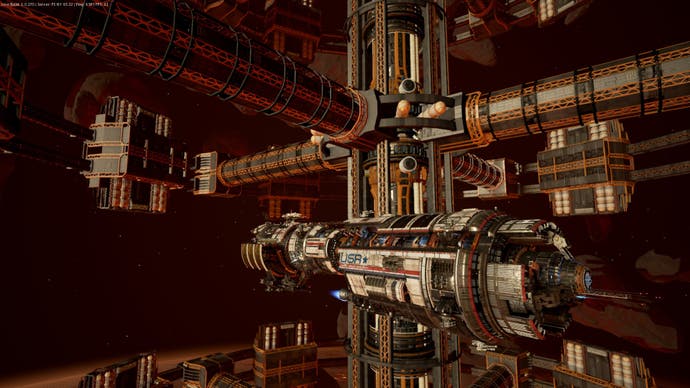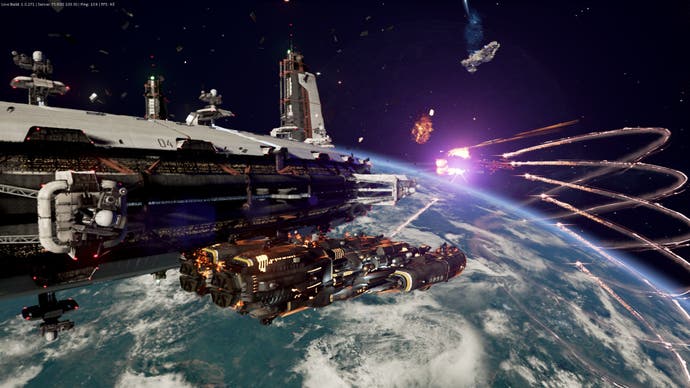Fractured Space review
Star League of Legends.
If you've ever looked at Eve Online's space fleet battles and wished you could participate, but have been put off by the job entry requirements - mandatory game subscription, weeks of basic training, sociopathic tendencies not required but a distinct advantage - then perhaps Fractured Space is worth a look. It's a Homeworld-infused take on League of Legends, offering the kind of year-round competitive play that participants in Eve's annual Alliance Tournament can only dream about.
Being squarely based on the world's favourite MOBA, Fractured Space's arena combat doesn't offer anything near the same scale as Eve's grand engagements, nor the alliance-ending consequences that come with sustained periods of victory or defeat. But neither do you have to endure four hour long mining sessions to replace lost ships, futile patrols to keep apathy at bay, nor feel yourself slowly transforming into the kind of self-entitled forum-dweller you've fruitlessly responded to your entire gaming life.
I jest of course - only macro bots mine these days - but you get my drift. Eve and its kind require a very specific set of qualities in order to gain full enjoyment from them; patience, a thick skin, skill. And time. Lots and lots of time - in amounts you may have had ten years ago when your fingers were permanently Cheeto-stained and there was an old Vimto bottle under the desk, but that today is as scarce as Arkanor in a hi-sec asteroid field. (Thems were the days, eh Eve vets?)

Even if you're not overly familiar with lane battles such as League of Legends provides, Fractured Space is a fairly simple game to get to grips with. The field of battle is divided into sectors that players jump their ships between. At the top and bottom of the sector map are yours and the enemy's Home Base, the destruction of which wins it for the other team. To get to it the teams needs to secure jump access through one or more of the three central sectors, either by taking and holding a Forward Base at the end of the two outer zones, or by leaping to the middle Gamma Sector when prompted to capture its only station - temporary control of which bestows your team with significant bonuses that become more decisive with each subsequent victory.
That sense of escalating tension common to the very best MOBAs is also fully present, as your team of initially timorous pilots starts to coalesce a strategy, sometimes instinctively, more often than not because someone is barking orders in the chat panel. Early efforts to capture mining bases to facilitate levelling and to probe enemy cohesion, hopefully by taking one or two of their number down, make way later on for desperate battles to close off enemy jump routes, or just to keep your ship together by taking cover behind space rocks - since each subsequent death lengthens the time to which you can re-enter the fray and support the war effort.
More distinct is that the game offers a singular and varied pace, with ships moving relatively slowly within zones, but that are able to leap between sectors almost instantly. Thus it is that while pitched battles are frequent and can evolve into quite intricate interplays of ship positioning, skill timers and players leading their targets, the detection of an enemy vessel carving a path through a undefended sector, or the Gamma phase timer ticking down, can facilitate a rush of jump activations as the action switches from sector to sector.
Being set in a 3D arena rather than across a flat surface, players are able to utilise the Z-axis as part of their control repertoire, sliding above or below the rich seams of cover provided by asteroids with the hopeful benefit that by being suitably distant from the central plane, their prey will be so fixated on the capture points in front of them that they'll to fail to notice what's about to it them..

While the number of vessels that can be unlocked (either via spending in-game credits earned through battle or by investing in Platinum, the game's premium currency) is far below the number of Champions in League of Legends' roster, there is more than enough ship variety to be getting on with. Divided more or less cosmetically between three manufacturers, ships either have a 70s sci-fi vibe, a slightly manic and intimidating Soviet-style functionality, or in the case of the TDS vessels, look to these Eve-trained eyes like an unholy fusion of Caldari and Gallente hulls, combining the angles of one with the curves of the other to great effect.
Functionally, which is of course where it matters, the ships are divided between light, medium and heavy, as well more fittingly between support, attack and defence. More often than not support ships are light and will come apart in a stiff solar breeze, defensive ships are heavy slug-throwing tanks and the medium ships will, if used optimally, deliver the most devastating and accurate blows. There is some deviance, of course, such as a heavy carrier that is more geared to support and a support ship that can go toe to toe with some of the game's most bruising attack vessels, not to mention a selection of long-range sniping vessels and stealth ships for those who prefer to operate independently from their teammates.
There are a number of things that are striking about the ships. Universally, the noise you hear when one jumps into the sector is beautifully evocative, which together with much of the weapons fire is reminiscent of Battlestar Galactica's one-sided battles, thus putting you on the defensive. Next is the way armour peels away when under intense bombardment, usually followed by billowing fires on all decks and ending with brief implosion that sucks any remaining life from your smouldering superstructure. A spectacular demise, it turns out, does a lot to eliminate any frustration.
More important than all the above is that the ships are supremely well balanced and surprisingly versatile, alluded to by their difficulty rating. "Easy" ships do best when sticking to their pre-ordained roles. For example the Protector is classed as an easy support vessel, which means it repairs damaged ships and does so very well. It can also temporarily stop an enemy ship in its tracks to buy a few seconds of time, but that's as far as it deviates from its main spec. Compare it to the "Hard" Disruptor, also a support ship, with less of an ability to heal allies, but able to, with some practise, cause quite a bit of non-lethal mayhem about the enemy ranks, such as slowing and disarming, as well a flitting about and being a pain in the ass thanks to something called a Blink Drive - an ability common to slow-moving close-combat ships that allows them to jump instantly a few kilometres ahead, usually throwing an enemy totally off their aim.
Despite having only a single map to study, 30-odd ships to unlock and a fairly thin selection of stat-tweaking sidegrades to play with prior to each battle (not unlike World of Tank's equipment upgrades, but without the scope to really upgrade anything), the small-scale nature of the 5v5 fighting means you can't hide your cluelessness under a mass of bodies like you can in one of Eve's 1000-player altercations. When you screw up in Fractured Space, by charging blindly into a trap, then your team will get to know about your foolhardy transgression. Not that you'll be savaged too much for displaying tactical naivety. Players are still getting to know their vessels and precious ranked matches are as-yet inaccessible, which distances the game's modest community a very long way from hitting Heroes of Newerth's 2012 levels of toxicity - at least for the time being.

Thanks in part to it's tutorial, a range of accessible ship videos and a community that is more tolerant than in most MOBAs, not to mention a helpful Firing Range area and solo battles to test out newly acquired ships, Fractured Space is a surprisingly welcoming experience, even if its 3D space battles can be fractionally disorientating to those more used to pushing their way along firmer territory.
The game isn't without a need for improvement. There's a distinct lack of in-game information to draw on, from an inability to meaningfully compare ships, loadouts and crew bonuses prior to battle, to having the required information to hand as to what buffs are active on you or your allies. As to the stability of the game, I've experienced some connection issues, all of them thankfully occurring prior to battle commencing rather than during, plus the relatively small player base means that the matchmaking system doesn't have the deepest well from which to draw its players, certainly during off-peak hours. Not that I've had to wait more than a minute or so for teams to fill up, which is par for the course whether many millions or just a few thousand are logged in to play.
It would be a shame if Fractured Space didn't grow to at least become a modest ongoing success. Though eminently watchable from an e-sporting perspective, it's hard to imagine the sci-fi setting and the severed play areas catapulting the game into the same big money gaming leagues that World of Tanks and Smite occupy, let alone LOL and DOTA2. But I suspect that, like me, a lot of people who'll come to try and enjoy Fractured Space aren't necessarily into MOBAs anyway and will gravitate towards the game because it offers accessible, generous and poised space battles, a range of attractive ships to fly and tinker with and only a fraction of the commitment that a game such as Eve currently demands.
Now if you don't mind I have some old bottles to clear out from under my desk.

